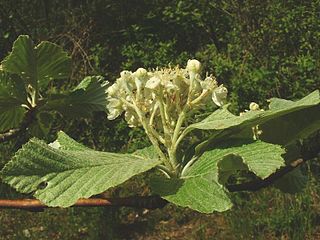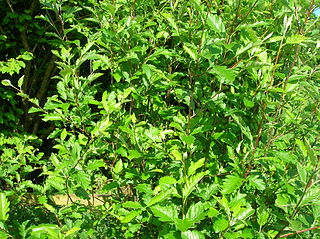The Arran whitebeams are species of whitebeam endemic to the island of Arran, Ayrshire, Scotland.
Hedlundia pseudomeinichii, known as false rowan and Catacol whitebeam, is a rare species of tree endemic to the Isle of Arran in south-western Scotland. It is believed to have arisen as a hybrid of the native European rowan and the cut-leaved whitebeam which is in turn a rowan/Arran whitebeam hybrid. Until 2020, only one living specimens of the Catacol whitebeam was known, at the time making it the rarest tree not only in Scotland, but joint rarest in the world with Wood's cycad. Another was recorded as a sapling, but is believed to have been destroyed by deer. A seedling and grafted plants have also been grown in Edinburgh.

Abies cilicica, also known as Cilician fir or Taurus fir, is a species of conifer in the family Pinaceae. It is found in Lebanon, Syria, and Turkey. Abies cilicica and Cedrus libani, together with Acer hyrcanum subsp. tauricolum and Sorbus torminalis subsp. orientalis, are the predominant trees in the phytocoenosis Abeti-Cedrion, a type of forest of the middle and eastern Taurus Mountains of Turkey. These forests occur between 800 and 2,100 meters elevation. Over 5,000 years of logging, burning, and grazing have reduced these forests to enclaves.
Glycosmis decipiens is a species of plant in the family Rutaceae. It is endemic to Peninsular Malaysia. It is threatened by habitat loss. A population is protected in Taman Negara.
Pandanus decipiens is a species of plant in the family Pandanaceae. It is endemic to the Philippines.
Pradosia decipiens is a species of plant in the family Sapotaceae endemic to Brazil. It is threatened by habitat loss.

Karpatiosorbus bristoliensis is a species of flowering plant in the family Rosaceae. It is known commonly as the Bristol whitebeam. It is endemic to Great Britain, growing wild only in the Avon Gorge and in the Leigh Woods area of Bristol. There are around 300 individuals as of 2016, and the population is thought to be increasing.

Aria eminens, commonly known as the round-leaved whitebeam, is a species of plant in the family Rosaceae. It is endemic to Great Britain and is threatened by habitat loss.
Aria lancastriensis, commonly known as the Lancashire whitebeam, is a species of deciduous tree or shrub in the family Rosaceae, growing to 6 m (20 ft). It is endemic to England, and is found within a 30 km (19 mi) radius from Morecambe Bay, in Lancashire. It is threatened by habitat loss. It has oval leaves. White blossom in spring is followed by orange to red berries in autumn.

Aria × leptophylla, commonly known as the thin-leaved whitebeam, is a species of plant in the family Rosaceae. It is endemic to Wales. It is a hybrid between Aria edulis and Aria porrigentiformis.

Sorbus maderensis is a species of rowan in the family Rosaceae that is endemic to Madeira. It is threatened by habitat loss.

Sorbus parumlobata is a species of plant in the family Rosaceae. It is endemic to Germany.

Hedlundia pseudofennica, also called Arran service-tree or Arran cut-leaved whitebeam, is a species of plant in the family Rosaceae. Endemic to the Isle of Arran in Scotland, it is threatened by habitat loss. It is thought to be a naturally occurring hybrid between H. arranensis and Sorbus aucuparia, probably with additional backcrossing with S. aucuparia. Hedlundia arranensis is itself a hybrid between Aria rupicola and S. aucuparia. Apomixis and hybridization are common in some groups of Sorbus species.

Karpatiosorbus subcuneata, the Somerset whitebeam, is a species of plant in the family Rosaceae. It is endemic to coastal north Devon and west Somerset in the United Kingdom. It is threatened by habitat loss.
Aria vexans, commonly known as bloody whitebeam, is a rare species of tree in the family Rosaceae. It is endemic to England and is found along the coast between Culbone in Somerset and an area just west of Trentishoe in Devon. It can be seen in the Exmoor National Park. It is threatened by habitat loss.

Sorbus wallichii is a species of plant in the family Rosaceae. It is found in China, India, and Nepal.
Aria wilmottiana, commonly known as Willmott's whitebeam, is a species of whitebeam in the family Rosaceae. It is endemic to England, and is found in the Avon Gorge, in Somerset and Gloucestershire. It is threatened by habitat loss.

Aria edulis, the whitebeam or common whitebeam, is a species of deciduous tree in the family Rosaceae. It is native to most of Europe as well as North Africa and temperate Asia. Typically compact and domed, with few upswept branches and almost-white underside of the leaves, it generally favours dry limestone and chalk soils. The hermaphrodite cream-white flowers appear in May, are insect pollinated, and go on to produce scarlet berries, which are often eaten by birds.

Karpatiosorbus devoniensis is known by the English name of Devon whitebeam and formally as Broad-leaved Whitebeam. When the fruit was reported as sold at Barnstaple Pannier Market the name French Eagles was used, apart from 1929 when they were reported as eagle-berries. When the trees were reported as seen growing wild on botanical walks they were referred to as French Hails. Broad-leaved white-beam, which was the common name until Devon Whitebeam took over, was used once in 1907.
As of July 2016, the International Union for Conservation of Nature (IUCN) lists 238 conservation dependent species. 0.29% of all evaluated species are listed as conservation dependent. The IUCN also lists seven subspecies and five varieties as conservation dependent.












